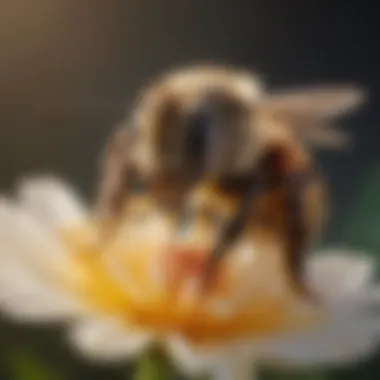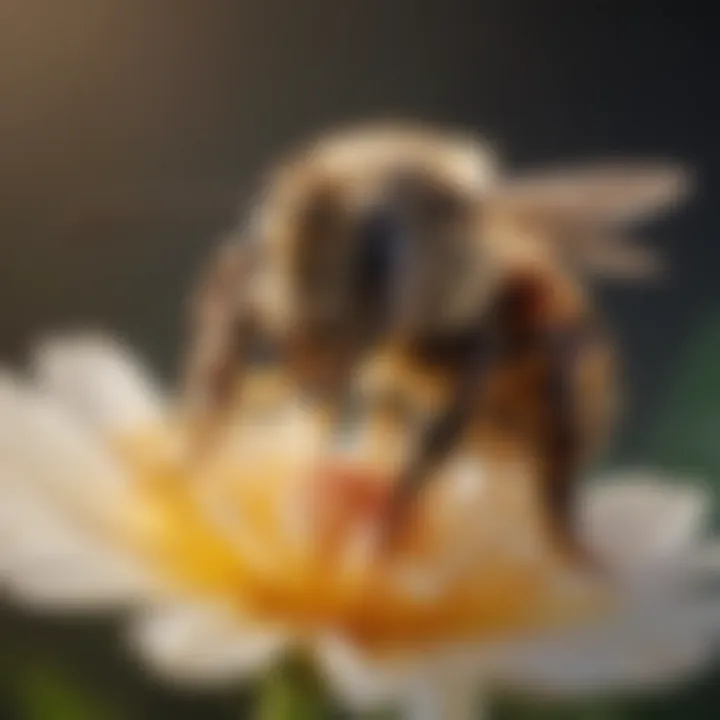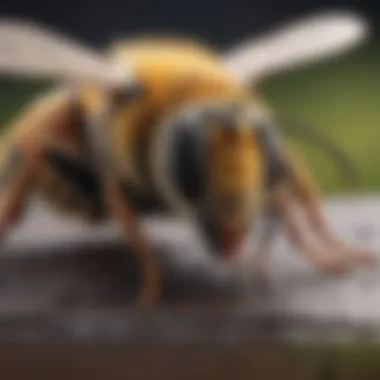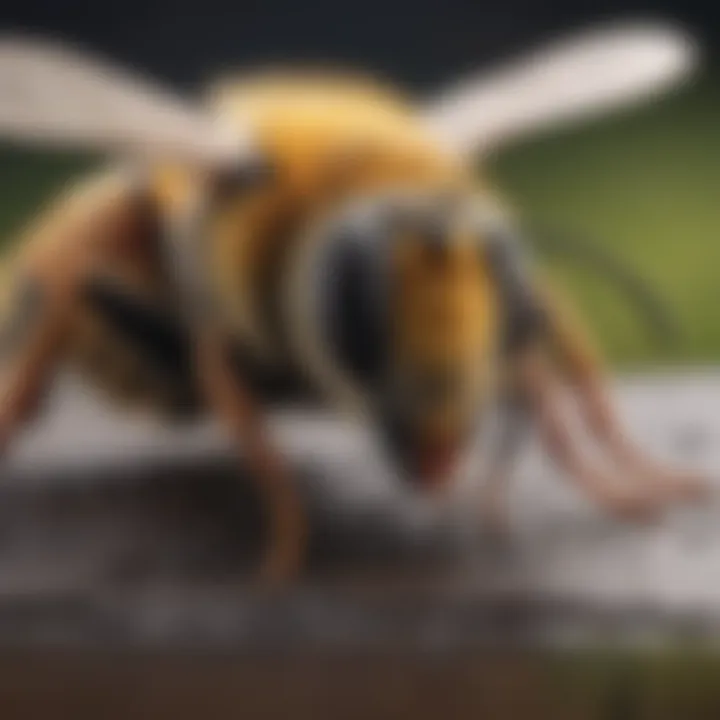The Impact of Pesticides on Pollinators Explained


Intro
The relationship between pesticides and pollinators has gained significant attention in recent years. This is mostly due to the alarming decline in pollinator populations globally. Understanding the effects of pesticides, particularly their varied impacts on key species like bees and butterflies, is essential for both ecological health and agricultural productivity. These chemicals, widely used in various agricultural practices, have complex implications that can disrupt the delicate balance of ecosystems.
Pesticides can alter pollinators' behavior and cognitive functions, affecting their survival and reproduction. Such changes thus create a ripple effect on the plants they pollinate. This article aims to clarify the multifaceted effects pesticides have on these crucial organisms, exploring different pesticide types, mechanisms of action, and regulatory frameworks guiding their use. The article will also consider alternative management practices designed to reduce dependence on these harmful chemicals.
As we dive deeper into this issue, it becomes clear that a thorough understanding of the interactions between pesticides and pollinators is imperative for researchers and policymakers alike. Reports and studies illustrate that the impacts of pesticide exposure can result in broader ecological repercussions. With this knowledge, effective strategies can be developed to mitigate risks while ensuring agricultural viability.
By examining these critical aspects, this discussion serves to enlighten educators, students, and professionals in the environmental and agricultural fields, equipping them with a comprehensive perspective on a pressing modern challenge.
Preface to Pollinators
Pollinators play a crucial role in the functioning of ecosystems and agricultural systems around the globe. Their importance lies in their ability to facilitate plant reproduction through the transfer of pollen. This process not only ensures the survival of numerous plant species but also contributes significantly to the production of fruits, vegetables, and nuts that are essential to human diets. The decline of pollinator populations raises significant concerns about food security and ecosystem stability.
Definition and Importance
Pollinators are organisms that aid in the transfer of pollen from the male structures of flowers to the female structures. This transfer can occur through various vectors, including wind, water, or animal interaction. The most well-known pollinators are bees, butterflies, birds, and bats. Their actions lead to the creation of seeds and fruits.
The importance of pollinators cannot be overstated. It is estimated that one-third of all food consumed by humans relies on pollination. Beyond food crops, many flowering plants depend on pollinators for reproduction, contributing to biodiversity.
Key Pollinator Species
Key species of pollinators include:
- Honey Bees (Apis mellifera): Renowned for their efficiency and productivity in pollination, honey bees are vital for many crops such as apples, almonds, and berries. They live in large colonies and have complex social structures.
- Bumblebees (Bombus spp.): These bees are known for their ability to pollinate plants that require buzz pollination. They are also crucial in cooler climates.
- Butterflies: Many flowers are adapted to attract butterflies with bright colors and scents. Butterflies contribute to pollination while they feed on nectar.
- Hummingbirds: Acting as pollinators in certain regions, hummingbirds are attracted to red or orange flowers. Their long beaks allow them to feed while transferring pollen.
Other significant pollinators include bats, moths, and beetles. Each species possesses unique traits that aid in the pollination process. Understanding these key species is fundamental, as their survival is increasingly threatened by pesticides and habitat loss, making this an urgent area of focus for researchers and policymakers.
"Pollinators are pivotal to ensuring plant reproduction and biodiversity across ecosystems. Without them, the stability of food production and natural environments would be severely compromised."
The interplay between pollinators, the plants they serve, and the broader ecological landscape underscores the importance of preserving and understanding these vital species.
General Overview of Pesticides
The study of pesticides is critical to understanding their effects on pollinators and the ecosystems in which they operate. Pesticides are substances designed to control or eliminate pests, including insects, weeds, and fungi. Their widespread use in agriculture and urban settings raises questions about the implications for pollinator health.
Understanding the types of pesticides and their mechanisms can provide insights into their impact on beneficial species. This knowledge is essential for developing practices that minimize harm while achieving agricultural goals.
Types of Pesticides
Insecticides
Insecticides are designed specifically to target insect pests. They play a significant role in agriculture by protecting crops from damage caused by harmful insects. One of the key characteristics of insecticides is their ability to disrupt the nervous system of targeted insects, leading to paralysis or death. This efficacy makes them a popular choice in pest control, particularly in large-scale farming.
However, the use of insecticides also raises concerns. Their non-specific action can harm non-target species, including vital pollinators such as bees. Neonicotinoids, a class of insecticides, are particularly noted for their detrimental effects on pollinator populations. While they can effectively manage pest populations, the long-term implications for pollinator health can be severe.
Herbicides
Herbicides target unwanted plants, often referred to as weeds, that compete with crops for resources. These chemicals are crucial for maintaining crop yields and are widely used in various agricultural systems. A key feature of herbicides is their selective action, which ideally removes weeds without harming the desired crops.
However, herbicides can also indirectly affect pollinators. For instance, the reduction of flowering weeds due to herbicide application can limit the food sources available for bees. This reduction in forage can lead to decreased survival rates among pollinators, demonstrating a significant downside to their widespread use in agriculture.
Fungicides
Fungicides combat fungal diseases that can devastate crops. Their role is critical in maintaining the health and productivity of agricultural systems. Fungicides work by inhibiting the growth or reproduction of fungi. A prominent feature of fungicides is their targeted action against specific fungal pathogens, which can prevent crop losses.


Nevertheless, like other pesticides, fungicides can pose risks to pollinators. Some studies indicate that fungicides can have sub-lethal effects on bees, affecting their behavior and reproductive capabilities. This aspect illustrates the complex interactions between agricultural practices and ecosystem health.
Mechanisms of Action
The mechanisms of action of pesticides vary widely depending on the specific type. Understanding these interactions aids in identifying potential risks to pollinators. For instance, many insecticides function as neurotoxins, interfering with neurotransmission in pests. This action can lead to rapid declines in targeted insect populations.
In contrast, herbicides and fungicides may interact with plants and soil chemistry, influencing the broader ecosystem. The specifics of these mechanisms demonstrate the necessity of comprehensive regulations and management strategies to mitigate negative effects on pollinator populations.
"Pesticides represent a double-edged sword, offering agricultural benefits but presenting significant risks to critical pollinator populations."
A thorough understanding of the dynamics surrounding pesticides is key to addressing the ongoing challenges posed by pesticide use and its impacts on pollinators.
Effects of Pesticides on Pollinator Physiology
The physiology of pollinators is crucial not only for their own health but also for the ecosystems they support. Pesticides have profound effects on these essential organisms, influencing their survival, development, and performance. Understanding how pesticides disrupt physiological functions provides insight into broader ecological consequences. This section will examine specific physiological impacts of pesticides that can cascade through populations and ecosystems.
Neurological Impact
Pesticides often target the nervous systems of insects. Many insecticides, particularly neonicotinoids, act as neurotoxins. They bind to nicotinic acetylcholine receptors, disrupting normal signaling. This can lead to symptoms such as tremors, paralysis, and ultimately death. Even sublethal exposures can impair communication and coordination among pollinators, which is critical during foraging and mating.
Research has indicated that exposure can alter behaviors like foraging efficiency and navigation. Bees that are subjected to pesticides may struggle to return to their hives or may not remember the flower locations they visited. This can lead to decreased pollination efficiency, impacting plant reproduction and survival.
Reproductive Consequences
The effects of pesticides on reproduction can be equally alarming. Studies show that exposure to certain pesticides is linked to reduced fertility and altered reproductive behaviors in some pollinators. For example, male bees can experience decreased sperm viability when exposed to specific chemicals. Female bees may face reduced ovary development or lower egg-laying rates.
Such reproductive harm poses substantial threats to population stability. A decline in reproduction can lead to reduced population sizes, further compounding the risks faced by pollinators. Observations in various studies suggest that these reproductive impairments could be significant enough to disrupt local populations over time, leading to regional declines.
Metabolic Disruption
Metabolic pathways are essential for maintaining energy balance and overall health in pollinators. Pesticides have been known to interfere with these metabolic processes, leading to energy depletion. Certain chemicals can disrupt mitochondrial function, which is critical for energy production. Without adequate energy, pollinators may not perform necessary activities like foraging or defending against pathogens.
Research has shown that metabolic disruption may also affect resilience against environmental stressors. Pollinators already facing habitat loss and climate change may find it challenging to cope when their metabolic processes are impaired by pesticide exposure. Thus, the interaction between pesticides and metabolic health is an area that requires increased focus within ecological studies.
Understanding these physiological impacts of pesticides is vital. It not only sheds light on the plight of pollinators but also emphasizes the need for responsible pesticide use and the exploration of sustainable alternatives.
Behavioral Changes in Pollinators
In understanding the impact of pesticides on pollinators, examining behavioral changes is crucial. Behavioral adaptations are often the first indicators of the adverse effects of pesticides. These changes can inform us about the overall health of pollinator populations. When pollinators alter their behavior, it can lead to a ripple effect in ecosystems, affecting not only the pollinators themselves but also the plants they pollinate and the agricultural systems that rely on them.
Pollinators like bees, butterflies, and moths play a pivotal role in maintaining the health of ecosystems by facilitating plant reproduction. This interconnectedness emphasizes the importance of examining how pesticides disrupt these natural behaviors.
Foraging Behavior
Foraging behavior is one of the most significantly affected behaviors in pollinators exposed to pesticides. A pollinator's ability to find and gather food is essential for its survival and the effective pollination of plants. Studies indicate that pesticide exposure can lead to reduced foraging efficiency.
Insects may show aversion to flowering plants treated with certain pesticides. This aversion can result in reduced visits to those flowers, ultimately impacting reproduction rates in those plants.
- Impaired Sensory Function: Pesticides can impair a pollinator's sensory capabilities, making it more difficult to locate food sources.
- Energetic Cost: Changes in foraging patterns can increase the energy expenditure needed to find food, leading to further physiological stress.
- Altered Preferences: Pollinators may alter their preferences for certain flower types, avoiding those they associate with negative experiences.
Navigational Skills
Navigational skills are critical for pollinators to traverse their environments effectively. Pesticides, particularly neurotoxic ones, can disrupt these abilities, making it difficult for pollinators to return to their nests or hives after foraging.
Research has shown that exposure to specific chemicals can impair cognitive functions related to navigation. This can lead to increased mortality rates as pollinators become disoriented and fail to find their way back home.


- Memory Impairment: Some studies have suggested that pesticide exposure can weaken the memory of pollinators, inhibiting their ability to remember landmarks.
- Increased Collision Rates: Disruption of flight patterns can cause more collisions with obstacles, further endangering pollinator species.
- Displacement: Pesticides may cause pollinators to stray further from their usual foraging routes, leading to a lack of access to regular food sources.
It is clear that changes in behavior due to pesticide exposure can have profound consequences on pollinator populations.
Understanding these effects highlights the need for more careful pest management practices that consider the behavioral health of pollinators.
Population Dynamics and Decline
Understanding the population dynamics of pollinators is crucial in grasping the extent to which pesticides influence these essential species. Pollinators not only contribute to the direct functioning of ecosystems but also play a significant role in agricultural productivity and food security. With the decline of pollinator populations, there is an imminent threat to biodiversity and the stability of agricultural outputs globally. This section will explore the specific elements that contribute to the decline of pollinator populations, the benefits of maintaining these populations, and the consequences of their decline.
Contributing Factors to Decline
Numerous interrelated factors contribute to the decline of pollinator populations, including the application of pesticides, habitat loss, climate change, and disease pressure.
- Pesticides: Certain insecticides, especially neonicotinoids, disrupt the nervous systems of pollinators, leading to neurological damage and impaired foraging skills.
- Habitat Loss: Urbanization and industrial agriculture reduce the natural habitats needed for pollinators to thrive. Loss of wildflower meadows and hedgerows limits their food sources and nesting sites.
- Climate Change: Altered weather patterns disrupt the life cycles of both plants and pollinators. Mismatched timings between flowering and pollinator activity reduce foraging opportunities.
- Disease and Parasites: Pathogens and parasites like the Varroa mite significantly impact bee populations, weakening their health and survival rates.
These factors do not act alone but often exacerbate one another, creating a compounded effect that accelerates decline. Understanding these dynamics helps inform strategies for mitigating losses.
Case Studies of Pollinator Declines
Several case studies highlight the alarming trends in pollinator declines worldwide, serving as real-world examples of the implications of pesticide use and other contributors.
- Honeybee Population Collapse in the United States: In recent years, the U.S. has seen a significant drop in honeybee colonies, a situation attributed to a mix of pesticides, habitat loss, and disease. Beekeepers report difficulties in maintaining healthy hives, which in turn impacts pollination activities crucial for crops like almonds and berries.
- Decline of Monarch Butterflies in North America: Monarch populations have been plummeting, with researchers linking part of this decline to pesticide exposure alongside habitat loss due to agricultural practices that remove milkweed plants—critical for their lifecycle.
- Bumblebee Declines in Europe: Numerous bumblebee species have experienced serious reductions in numbers across Europe. Studies show that pesticide use, particularly in agricultural contexts, correlates with population declines. Local extinction rates have increased, leading some species to be classified as endangered.
These case studies provide a clear illustration of how multi-faceted issues combine to threaten pollinator populations.
Regulatory Frameworks Surrounding Pesticides
Regulatory frameworks surrounding pesticides play a pivotal role in safeguarding pollinator health and sustainability. These frameworks also ensure that agricultural practices do not compromise ecosystem balance. By establishing guidelines and standards for pesticide use, these regulations aim to minimize hazards to pollinators, which are essential for ecosystem functioning. Policymakers, researchers, and stakeholders must consider the impacts of pesticide application not only on targeted pests but also on non-target species such as bees and butterflies.
Effective regulations can lead to better agricultural practices that align with environmental conservation. This preventive approach can mitigate pollinator declines linked to chemical exposure. Furthermore, understanding these frameworks helps farmers and agricultural practitioners make informed decisions regarding pest management while complying with legal requirements.
"Regulatory guidelines are crucial for maintaining not just a healthy agricultural sector but also a thriving environment, which in turn supports pollinators."
Global Standards and Policies
Global standards for pesticide use are integral to the international effort to protect pollinators. Organizations such as the Food and Agriculture Organization (FAO) and the World Health Organization (WHO) develop comprehensive guidelines that define acceptable practices for pesticide application. These guidelines are designed to create a uniform approach to managing pesticides, focusing on safety and environmental stewardship.
In addition to these standards, programs such as the Rotterdam Convention help control the international trade of hazardous pesticides. By adhering to these global policies, countries can work towards a more sustainable agricultural model. However, it remains essential for nations to customize these standards to fit their unique ecological conditions and agricultural practices.
Country-Specific Regulations
Country-specific regulations reflect local environmental conditions, agricultural methods, and cultural practices. Each nation must assess its own pesticide-related risks and establish appropriate laws to govern their use. For example, the European Union has strict regulations under the REACH (Registration, Evaluation, Authorisation and Restriction of Chemicals) regulation, which imposes thorough safety assessments before pesticides can enter the market. Conversely, in the United States, the Environmental Protection Agency (EPA) enforces regulatory measures that include the approval process for pesticide registration based on risk assessments to human health and the environment.
Stringent country-specific regulations can greatly influence agricultural practices. In nations where regulations are enforced rigorously, farmers may adopt more sustainable methods, such as integrated pest management, which balances pest control with environmental care. As a result, these regulations have long-term benefits for both pollinators and the agricultural ecosystem.
In summary, understanding the regulatory frameworks governing pesticide use is essential for evaluating their impacts on pollinators. By fostering an environment where safety and sustainability are prioritized, stakeholders can ensure pollinator health while maintaining productive agricultural systems.
Alternative Pest Management Strategies
The significance of alternative pest management strategies cannot be understated when addressing the detrimental impacts of pesticides on pollinators. As the ecological balance becomes increasingly fragile, exploring methods that reduce reliance on chemical pesticides is essential. These strategies not only help protect pollinator populations but also maintain the integrity of ecosystems and agricultural productivity.
Engagement with these alternatives leads to various benefits. First, reducing chemical exposure to pollinators contributes to their health and survival. Many strategies allow for the control of pests without the harsh effects associated with synthetic pesticides. Furthermore, by adopting alternative methods, farmers can become more sustainable in their practices, which enhances soil health and biodiversity.
Integrated Pest Management (IPM)


Integrated pest management (IPM) is a holistic approach that combines multiple strategies for pest control, striking a balance between ecological health and agricultural demands. IPM emphasizes monitoring pest populations and assessing the damage they cause instead of applying pesticides indiscriminately. This method involves various techniques such as crop rotation, habitat manipulation, and biological control.
On the operational level, IPM practices can include:
- Regularly scouting fields to monitor pest levels.
- Using economic thresholds to determine when action is needed.
- Implementing biological control by encouraging natural predators or parasites.
Additionally, educating farmers about pest identification can lead to better decision-making. The focus is on prevention and management rather than eradication.
Biological Control Methods
Biological control methods exploit natural enemies of pests to reduce their populations. This technique includes the use of predators, parasites, or pathogens that specifically target pest species, thus minimizing the impact on non-target organisms, including pollinators.
Several examples of biological control include introducing lady beetles to feed on aphids or deploying nematodes against soil-dwelling pests. This approach offers a sustainable alternative to chemical pesticides, respecting the ecological balance.
One of the major advantages of biological control is its adaptability. The method can be tailored to specific pest problems, allowing for effective management that can evolve with changing pest dynamics. However, careful assessment is required to avoid disrupting existing ecosystems. In summary, biological control methods fortify pest management strategies while being less harmful to pollinator health.
Mitigation Strategies for Pesticide Use
Mitigation strategies for pesticide use are essential in addressing the adverse impacts of pesticides on pollinators. These strategies are designed to reduce harm to beneficial insects while maintaining effective pest control in agricultural practices. With the growing awareness of the role of pollinators in ecosystems and food production, it becomes increasingly important to find a balance between agricultural productivity and environmental health.
The implementation of effective mitigation strategies can lead to several key benefits. Firstly, these strategies help protect the biodiversity of pollinator species, which is crucial for sustaining healthy ecosystems. Secondly, they create a more favorable environment for agricultural practices that rely on pollination, thus bolstering productivity. Additionally, such strategies often enhance the public image of agricultural operations, as they demonstrate a commitment to sustainable practices.
Key considerations in advancing these mitigation strategies include:
- Understanding the specific behavior and life cycles of pollinators so that pesticide applications can be timed to minimize exposure.
- Employing precision farming techniques to apply pesticides in targeted areas rather than blanket spraying whole fields.
- Using alternative pest control methods in conjunction with traditional pesticides to reduce dependency on harmful chemicals.
By integrating these aspects, it is possible to create an effective framework for pesticide application.
Innovative Application Techniques
Innovative application techniques play a significant role in mitigating the impact of pesticides on pollinators. Such techniques focus on improving the precision and timing of pesticide applications to substantially decrease non-target exposure.
- Drone Technology: Drones are being used to precisely apply pesticides in specific areas, reducing drift and unnecessary exposure to surrounding pollinator habitats.
- Targeted Spraying: Methods such as electrostatic sprayers can help ensure that pesticides adhere to plants more effectively, minimizing environmental loss.
- Biopesticides: Utilizing biopesticides derived from natural materials can reduce harmful effects while maintaining efficacy against pests.
These techniques are not merely advancements; they signify a paradigm shift towards health-conscious agricultural practices.
Increasing Public Awareness
Increasing public awareness about the impacts of pesticides on pollinators is crucial for fostering community support and encouraging responsible pesticide use. Educating the public can empower consumers to make informed choices and influence agricultural practices.
- Public Campaigns: Informative campaigns can disseminate knowledge about the benefits of pollinators and the potential threats posed by pesticides.
- Collaborative Initiatives: Partnerships between agricultural stakeholders, environmental groups, and educational institutions can improve outreach efforts and create platforms for discussion.
- School Programs: Integrating pollinator education into school curricula can help cultivate a new generation that respects and values ecological balance.
Ultimately, awareness-raising efforts can lead to increased demand for sustainable practices and products, encouraging farmers to adopt more pollinator-friendly methods.
By prioritizing mitigation strategies, agricultural practice can evolve. Acknowledging the significance of pollinators in the food chain while embracing innovative approaches sets a foundation for sustainable agriculture.
Closure
The conclusion of this article synthesizes the intricate relationship between pesticides and pollinators, providing a critical examination of the findings presented. Understanding the impact of pesticides is imperative for multiple reasons. First, it allows researchers, policymakers, and agricultural practitioners to recognize the role that pesticides play in pollinator health, which directly affects ecosystem stability and agricultural output. Recognizing this link can lead to informed decisions that balance agricultural needs with environmental sustainability.
Summary of Findings
Several key points emerge from the discussion:
- Diverse Effects: Pesticides affect pollinators physiologically, leading to neurological disruptions, reproductive issues, and metabolic imbalances.
- Behavioral Impact: Changes in foraging behavior and navigational skills have been observed, which can have cascading effects on pollination efficiency and ultimately crop yields.
- Population Decline: The decline of pollinator populations can be attributed to multiple factors, with pesticide exposure being a significant contributor.
- Regulatory Frameworks: Current regulations vary globally, emphasizing the need for cohesive standards to mitigate the harmful effects of pesticides on pollinator species.
- Adoption of Alternatives: Integrating alternative pest management strategies, such as Integrated Pest Management (IPM) and biological controls, presents pathways to reduce reliance on synthetic pesticides.
Future Directions in Research
There are several avenues for future research that could yield significant insights into this complex relationship:
- Longitudinal Studies: Conducting long-term studies on pesticide exposure and its cumulative effects on various pollinator species would enhance understanding of their ecological roles.
- Health Assessments: Investigating health markers in pollinators can provide a clearer picture of how pesticide exposure impacts their overall well-being and productivity.
- Innovative Practices: Researching innovative application techniques that minimize pesticide drift and enhance targeting can help preserve pollinator populations while ensuring crop protection.
- Public Engagement: Studies focused on how to effectively communicate the risks of pesticides to the public and farmers can lead to more responsible use practices.
- Ecosystem Interactions: More research on how pollinators interact with other species within their ecosystems is essential to understand fully the consequences of their decline due to pesticides.
By exploring these areas, the goal is to create a comprehensive understanding of the various factors at play in the relationship between pesticides and pollinators, ultimately facilitating better practices that support both agriculture and environmental health.



